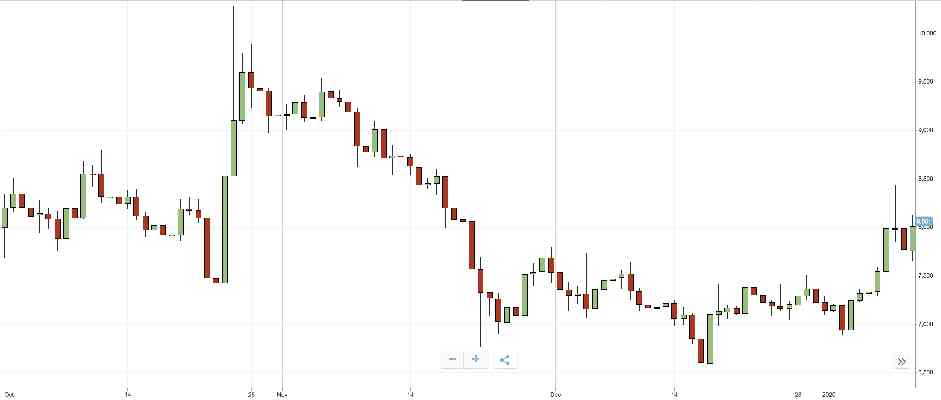Despite common fluctuations in price , Bitcoin ‘s performance throughout 2019 was somewhat unremarkable.

We’ve taken a closer look at the cryptocurrency ‘s price movements, focusing specifically on its performance during Q4 2019.
But, first, let’s briefly recap Bitcoin ‘s performance during the first nine months of the year.
Bitcoin was relatively stable from January to March 2019.
It started the year off at $3,717 and a brief 9-percent increase in its trading price saw it surpass the $4,000 barrier during the first week of January.
The upward trend was short-lived, though. Within a month, its price fell to a low of $3,358 on February 7.
From then on, Bitcoin demonstrated some relative stability but experienced a notable drop at the end of February where its trading value dropped 8 percent from $4,106 — its highest price during Q1 — to $3,784 over a 24-hour period.
By March, Bitcoin had almost equaled its quarter high and closed trading at $4,092, representing a modest 10-percent growth for the quarter .
The second quarter of 2019 proved to be much more fruitful for investors and hodlers.
Bitcoin opened April at $4,125 — marking the start of a three-month- long rally.
Over Q2, Bitcoin set numerous records for reaching prices that hadn’t been seen over the previous 12 months.
At the height of summer, in July, Bitcoin opened above the $10,000 mark, hitting $10,442.80 on the first day of the month. It then went on to surpass $11,000 within the first two weeks of the quarter .
The quarter ‘s highest value was hit in early August , when the digital currency surpassed $11,000, trading at $11,815.04 on August 7.
However, a week later, on August 14, Bitcoin ’s trading price decreased by 14 percent, stabilizing at $10,137.88.
The month of August ended with Bitcoin trading well below $10,000, and costing just $9,462.50 on August 31.
Bitcoin started trading at $9,603.10 on September 1, increasing by 7 percent and hitting $10,363.03 the following day.
The digital currency hovered around the $10,000 mark for most of the month, until it dropped to $9931.40 on September 21 and continued to plummet over the next three days, leaving it sitting at $8,549.93 on September 24. Its lowest value for Q3 was reached on September 29 when it was trading $7,994.55.
October saw Bitcoin trade at prices unseen since the previous month of June.
It was hovering around $8,343.93 before falling by 5 percent to $7879.23 on October 6. It then recovered slightly, reaching $8195.13 the following day.


The biggest drop happened October 24, when the cryptocurrency plummeted to $7421.20.
Three days later, on October 27, Bitcoin would gain momentum to reach both the month’s and quarter ‘s high at $9595.34.
By October 31, the cryptocurrency was trading at $9160.55.
Bitcoin remained relatively stable during the first few days of November 2019, maintaining around and above the $9,100 mark.
It jumped to $9,396.19 on November 4 before dramatically dropping to $8,771.30 on November 9.
Then things went from bad to worse . On November 10, Bitcoin was trading for $9,009.69 a coin but it began to plunge in the following days and weeks, hitting $7,026.83 on November 24.
The cryptocurrency remained well below the $8,000 mark for the rest of the month, finishing on $7,528.47 on November 30.
On December 1, Bitcoin was sitting at $7,265.69 and it remained above the $7,000 mark during the first fortnight of the month.
The cryptocurrency experienced somewhat of a rally mid-month, hitting $6,861.92 on December 16 and going on to reach $7,252.71 on December 18.
Bitcoin peaked on December 23, trading at $7,580.20 a coin .
It then finished the month on December 31 hovering at just over $7,100.
Q4 2018 vs Q4 2019
Bitcoin’s price was definitely higher during Q4 2019 than in Q3 the previous year.
In October 2018, Bitcoin was trading for way below $7,000, sitting roughly around the $6,500 mark.
The cryptocurrency ‘s performance followed the same line throughout the following month. It peaked momentarily during the first week of November going slightly above $6,500 before plummeting by more than $1,000 and sitting just above $5,500 on November 18.
Bitcoin continued to drop finishing the month well below $4,000.
At the beginning of December 2018, Bitcoin was hovering close to $4,200 and remained below the $4,000 throughout the rest of the month.
Major events during Q4 2019
In early October, Russia reportedly enacted a new “ digital rights act” that defines smart contracts and cryptocurrency tokens. Although the country is yet to fully embrace cryptocurrency , this was largely perceived as a step toward potentially regulating the space .
Several days later, Bitcoin made headlines by association after German police executed a hi-tech raid on a data processing centre installed in an ex-Nato bunker. The bunker allegedly hosted dark web sites to deal drugs and child abuse imagery.
Ohio, the first US state to accept Bitcoin for taxes, suspended its cryptocurrency payment system meaning businesses can no longer pay in digital assets.
Europol said Bitcoin was still very much the dark web ‘s favorite cryptocurrency but noted that those looking to cover their tracks were slowly learning to use privacy-focused alternatives.
Authorities charged a 23-year-old South Korean man of running the world’s “largest child sexual exploitation market ,” which reportedly processed 7,300 Bitcoin transactions worth over $730,000.
Cumulative Bitcoin transaction fees surpassed the $1 billion milestone in mid-October.
Bitcoin -hungry hackers gave the city of Johannesburg three days to pay more than $30,000 worth of the cryptocurrency .
Finally, a report by marketing analysis firm SEMRush claimed Bitcoin was the third most popular method for online payments in Italy, beating payment processor PayPal and Italian prepaid cash card provider PostePay.
Looking ahead
It’s never easy to predict Bitcoin ‘s price movements, but the cryptocurrency has been moving upwards so far this year.
Having landed January above the $7,100 mark, Bitcoin has remained relatively stable, maintaining itself mostly above $7,000 but well below $8,500.
While these values are not necessarily encouraging — especially if we look back to January 2018, when one coin was priced at well over $13,343.71 — they’re a significant improvement when compared to Bitcoin ‘s lowly price of $3,000-$4,000 this time last year.
Colorado senator wants to study blockchain for water rights management
A senator in Colorado wants the state to study the potential use of blockchain technology in water rights management.

A bill submitted by Republican senator Jack Tate, alongside representatives Jeni James Arndt, and Marc Catlin, outlines the reasons why the Colorado Water Institute should be authorized to explore how the technology could help maximize operational efficiency, CoinDesk reports .
According to the bill, the institute should look at possible use cases including applying the technology to manage a database of water rights and facilitating the establishment or operation of water markets or water banks.
The submission of the bill comes a month after IBM announced a collaboration with Freshwater Trust and SweetSense, which saw the companies leverage blockchain and IoT to track the Sacramento San Joaquin River Delta in California in “real-time.”
Despite the hype, which can lead many to believe blockchain technology is a solution looking for a problem to solve, the lawmakers’ approach isn’t that far-fetched.
There are no details on what sort of blockchain model they’d rely on, but public blockchains could serve as a viable solution for water rights management.
Data pertaining to water quantity and quality could be tracked on a blockchain, meaning it would be impossible for a corrupt agent such as a government or organization to hide it or tamper with it.
In turn, the data collected could be used to make better decisions, particularly in the face of increased water scarcity in some regions across the world.
While enterprises such as IBM are already exploring the use of the technology, it’s interesting that lawmakers are keen on following suit.
Want more blockchain news? Come to TNW2019 , our tech conference in Amsterdam, and check out our Hard Fork track .
Understand blockchain – and why everyone won’t shut up about it
Blockchain, a distributed ledger that connects a growing list of blocks of data, is a decentralized technology that records transactions between two parties.

Resistant to tampering once blocks have been added to the network, the technology delivers a concrete database of information that is secure and is continually being updated across a network of computers known as nodes. In order to ensure that copies of the database are the same, checks are constantly undertaken by the network.
There are essentially three parts to the recording process: the record between the parties involved, the block, which is where records are put together, and the chain where all the blocks are eventually added.
How does a record get added to the blockchain?
Let’s take the familiar characters, Alice and Bob.
Alice is selling four of her coins to Bob for $200. The record lists details of the transaction, including a digital signature from each person and timestamp.
The record is then checked by the network, with nodes ensuring that the details of the transaction are valid, for instance, does Alice have the four coins she claims to sell to Bob? Once the information has been confirmed as true, the record is accepted by the network.
The record is then added to a block along with other records, which will be included to the blockchain. Each block has a unique hash code attached to it and contains a cryptographic hash of the previous block in the chain.
The block is then added to the blockchain with the hash codes showing the order the blocks are connected. This process is then repeated when another transaction is made.
It is the hash codes which keep the blockchain safe as they are difficult to change. A hash code is created by a mathematical function that generates 64 numbers and letters. Regardless of the file size, it will always make up a string of 64 numbers and letters, each of which will be unique.
So, if Alice wanted to change the transaction with Bob, any change to the original hash code would create a new one. This, in turn, would break it from the block it was attached to as that one still holds the original hash code.
In order to restore the block, Alice would have to change the next block, breaking it from the one it was originally linked to. She then has to recalculate that block to connect the chain again, and so it would continue until the first ever block launched. However, the likeliness of this taking place is slim due to the difficulty involved and the significant amount of computing power to do so.
The evolution of the blockchain
The blockchain is primarily linked to the existence of Bitcoin. Created by a pseudonymous person or group of people known as Satoshi Nakamoto, the first block, known as the Genesis Block , was launched on the network in early 2009, starting the Bitcoin blockchain.
Since then it has evolved into something much greater, with other blockchains coming into existence: Ethereum, EOS, Cardano, IOTA, Stellar, and NEM to name a few, all of which are creating something different for the advancement of the technology.
For now, though, the Bitcoin blockchain’s most popular use case is cryptocurrencies.
This is down to the fact that cryptocurrencies are aiming to solve a problem: giving people back control of their money, which Nakamoto noted in Bitcoin’s white paper .
Aside from cryptocurrency use cases, the technology can be used for almost anything of value, but still has some maturing to do. Some of the areas the technology is being applied include supply chains, banking, voting, healthcare, and property rights, which are all in varying stages of development.
Other blockchains
Ethereum
The Ethereum blockchain is one of the biggest by market cap – and some even say its blockchain network might even be bigger than Bitcoin. This is a decentralised ledger that lets developers create and deploy smart contracts and decentralised applications (dapps).
Similar to Bitcoin’s blockchain, in that nodes on the network share a record of each transaction, the only difference is that Ethereum focuses on running smart contracts. This is achieved with its programming language Solidity, forming them through the Turing-complete Ethereum Virtual Machine (EVM). A Turing-complete system is a programming language that enables users to specify actions, which will automatically allow policies or smart contracts to execute at any given time.
It is these smart contracts which can move value around and represent the ownership of property without needing a middleman. A few examples of where smart contracts are being used include real estate, property deeds, banking, and healthcare. Similar to how a traditional agreement works, smart contracts define rules and penalties; however, they are automatically able to enforce the obligations of the agreement.
Another side of Ethereum is the area that focuses on dapps. These have real-life use cases ranging from job marketplaces to virtual games. One dapp that gained popularity when it launched in 2017 was CryptoKitties, a blockchain-based video game that lets users buy, collect, sell, and breed different virtual cats. The popularity of it reached a point when one cat was sold for $170,000 .
Cardano
Home of the ADA altcoin, Cardano is a decentralized public blockchain and cryptocurrency project. According to its website, it’s “developing a smart contract platform which seeks to deliver more advanced features than any protocol previously developed.”
The network uses its proof-of-stake algorithm Ouroboros, which determines how individual nodes reach a consensus about the network. In December, IOHK, the blockchain research development company, which is one of the organisations developing Cardano (the others being the Cardano Foundation and Emurgo), announced the launch two development tools in test format: Plutus and Marlowe.
These will enable startups and financial services to write smart contracts on the Cardano blockchain.
Even though this is available in a test format, it remains to be seen if and when financial services and startups will implement the tools available.
Stellar
Stellar is a blockchain-based ledger that is working to connect banks, payment systems , and people.
According to its website, the platform is aiming to “expand access to low-cost financial services to fight poverty and maximize individual potential.” It claims to enable thousands of transactions per second by moving money across borders, which it states is reliable and quick for a low fee.
Yet, as the Stellar network works within banks, it’s considered a centralized process. It remains to be seen what clear benefits will be seen for the end consumer.
Ripple
Similar to Stellar, Ripple is aiming to enable “secure, instantly and nearly free global financial transactions of any size with no chargebacks.” It’s also not completely decentralized.
The Ripple ledger is built on an open source protocol, and “supports tokens representing fiat currency, cryptocurrency, commodities , or other units of value such as frequent flier miles or mobile minutes,” according to Wikipedia. Ripple has a native cryptocurrency called XRP as well, which is one of the largest cryptocurrencies by market cap.
Among its customers, it counts a number of large banks, payment providers, and currency exchange services.
These are just a few of the blockchains available. Yet, they paint a picture of where the technology has come and shows how it’s continuing to advance. It’s important to note, though, that each of these blockchains are still very much in the early stages of development. Much has yet to be done to determine their impact and how they could change the way we conduct business.











